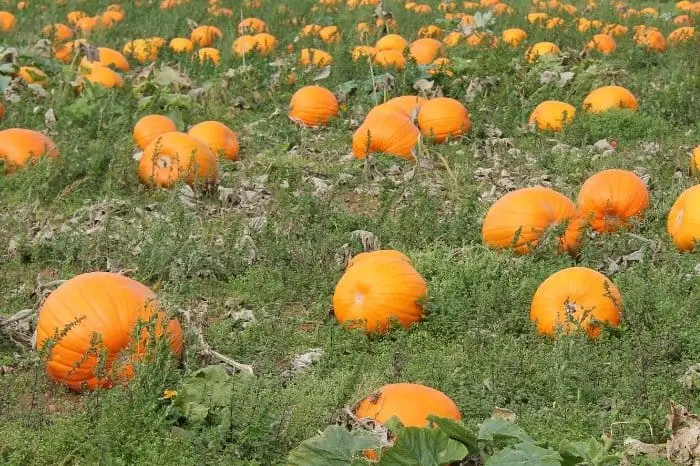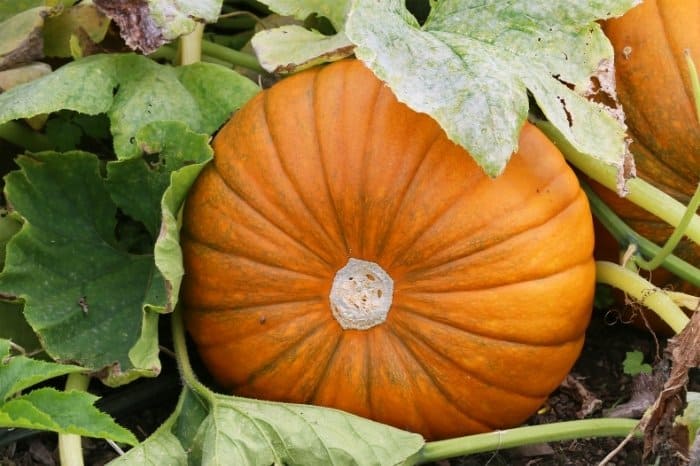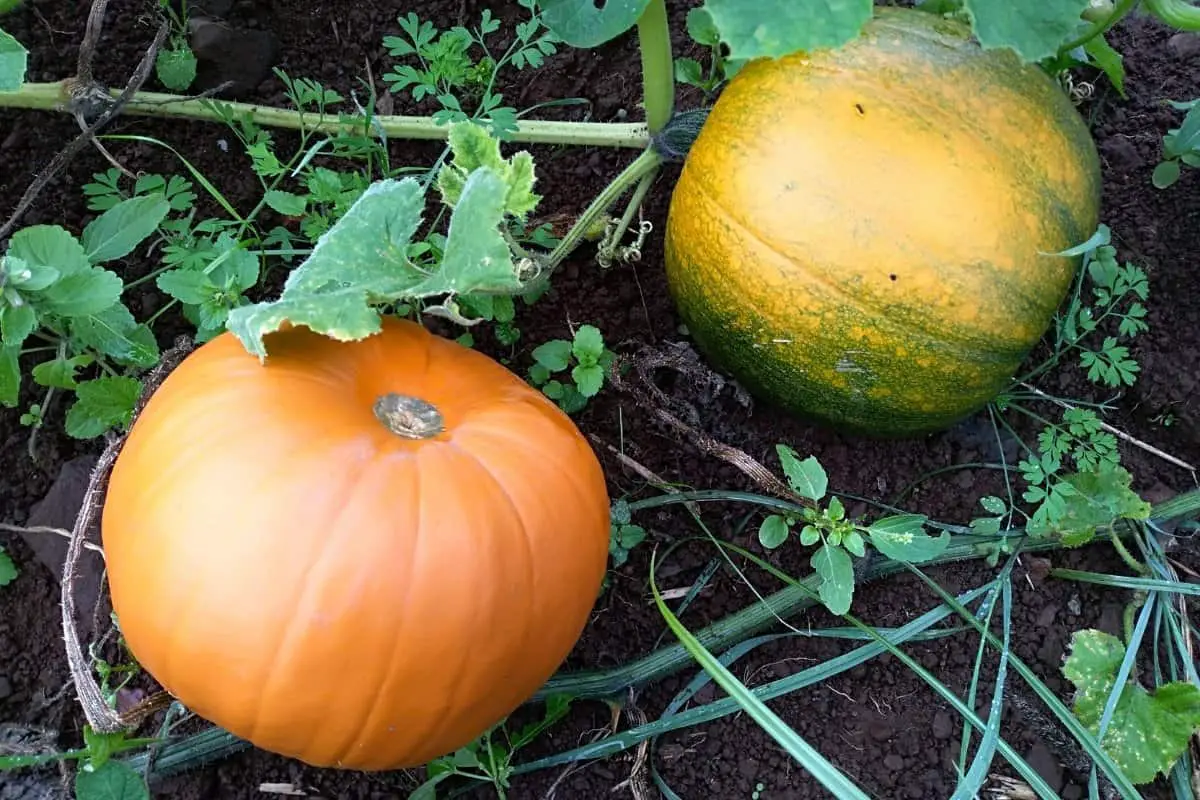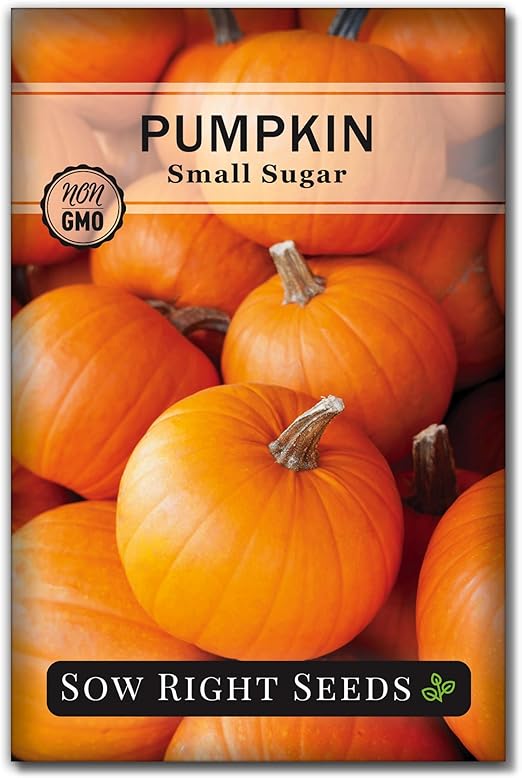Last Updated on February 9, 2022 by
The most natural question most gardeners ask after planting is how many pumpkins per plant will they get and how to improve this number.
The answer is a combination of many factors that will look at in this article to enable you to grow your pumpkins with a clear picture.
So How Many Pumpkins Per Plant?
The answer to this question comes down to what your goal for your pumpkin harvest is.
Do you want to grow a giant pumpkin like the Dill’s Atlantic Giant Pumpkin? Then you will need to optimize the plant conditions so that it sends all the resources – water, nutrients, and sunlight to a single pumpkin instead of multiple pumpkins competing for growth.
If you target to grow normal to larger-sized pumpkins like the popular Cinderella Pumpkins, try to go for at least 2 pumpkins per plant. In general, a single pumpkin plant can produce around 2 to 5 pumpkins; however, this depends on the variety.

Miniature pumpkin varieties like the Jack B, also known as JBL, can produce as many as 12 pumpkins. This is understandable as each of those pumpkins fits in the palm of your hands and doesn’t take much space as the larger varieties do.
Larger pumpkin varieties like the Kratos Hybrid Pumpkin grow one pumpkin per plant that is about 14 inches in size and weighs about 14kgs.
To get a good harvest, it’s important to keep the pumpkin plants free from weeds by hoeing or through shallow cultivation. If you experience extended dry periods in the summer, be sure to irrigate with plenty of water. Pumpkins plants tolerate periods of hot and dry temperatures very well, but they are always thirsty for water.
Is There Any Way Where Pumpkins Per Plant Are Too Many?
The general rule for normal pumpkins is a target of 3 fruits per plant. 4 fruits and beyond is a crowd.
These per plants limitations come from the single biggest factor – the vines. The wilder the vines, the more pumpkins per plant. These pumpkins will need more room to grow, run, climb, and get the much-needed air. Overcrowding and lack of enough nutrients are some of the reasons these pumpkins will not produce much.
Sow Right Seeds – Small Sugar Pumpkin Seed for Planting – Non-GMO
How Long Do Pumpkins Take To Grow After Flowering?
It takes about 80 to 120 days, from planting to harvesting a pumpkin.
Pumpkin plant growth stages start with pumpkin seeds. They take 5 to 10 days to sprout and begin growing. To help them grow, ensure that the plant gets enough sunlight for at least 6 hours of direct sunlight.
Pumpkin requires plenty of water to encourage fast growth of the vine and flowering. Be careful not to overwater it, and don’t allow its roots to soak in standing water.
When growing your pumpkin in the container, ensure there is proper drainage to remove excess water. Use a pot with lots of holes at the bottom when planting pumpkins.
From flowering to fully mature pumpkins, it takes 45 to 55 days. Pumpkin flowers require pollination to reduce this time. The flowers, when not pollinated on time, wither and fall off without producing any pumpkin. Bees and other insects are essential for a natural way of pollination.
Planting other ornamental flowers in or around your garden attracts bees and insects that help with pollination. If there are no bees or insects in your garden, you might have to fertilize it manually.
Pumpkins have 2 types of flowers – male and female. The make flower grows first and does not produce any fruit. A few days later, the female flower appears after a male flower and is responsible for bearing the fruit.
Use a cotton swab or paintbrush to rub pollen from the long-stemmed male flower and use it to pollinate the female bud. A week after pollination, you will notice the flower begins to start bulging and forming into a pumpkin.
How Much Space Does A Pumpkin Plant Need?
Pumpkins need lots of space no matter the variety they choose to grow. Large and giant pumpkins require more than 70 square feet per plant to give you the best crop. Given so much space to grow, this pumpkin can reach a size that is several hundred kilograms when mature. Midsize pumpkin varieties like the Jack-O-Lantern and Howden require 5 feet between plants and 4 feet between rows for improved harvest.
Pumpkins are 90% water; therefore, ensure you provide them with plenty of water; otherwise, you might experience low yield from the most vigorous varieties. Small and miniature pumpkins should be planted at least 2 to 3 feet between plants with sow spacing of 6 to 10 feet apart.
How To Farm Pumpkins If You Have Small Space
Pumpkins are known to thrive in large spaces. Their vines grow to sizes greater than 20 feet or more. Be sure to choose an area where plants have plenty of room to grow.
If you have limited space, you can still grow pumpkins, but it will require some extra work. As long as the vines are still young, direct their position to grow where you want them to. When the vine starts flowering, leave them alone to grow.

Consider growing smaller varieties like the famous bumpkin pumpkin or Baby Boo if your space is too limited. Some of the smaller varieties might not be edible, be sure to check before growing yours.
FAQs
How many pumpkins will I get from one plant?
A single pumpkin plant will produce a lot of pumpkins. It's not unusual to have 5-10 pumpkins on a single plant, and some plants may even be able to grow pumpkins all year long. The number of pumpkins per plant is dependent on the cultivar you choose, your soil, your weather conditions, and whether you grow your pumpkins in a greenhouse or in the garden.
Some people even plant a single pumpkin plant in their front yard each fall!
What do i need to do to get numerous pumpkins?
If you have never planted pumpkins before, you are in for a big surprise. Pumpkin seeds do not grow into pumpkins in one season. It takes three to five years for a pumpkin seed to mature into a pumpkin. It is important to know how much space you will need to grow your pumpkins.
Pumpkins need room to grow and develop properly. They can get as large as 10 to 12 pounds. You will also need some soil, a shovel, a trowel, and a hoe.
You can start a pumpkin seed indoors in a small container. Then you plant the seeds in the ground outside once the weather warms up.
In order to get a good harvest of pumpkins, you need to start your seeds indoors and transplant them into the garden once they are big enough to handle the move. You can start a pumpkin seed indoors in a small container. You can grow them on a window sill.
What should I do if I only have one pumpkin?
The first step is to examine the pumpkin for obvious signs of disease or injury. Is it discolored or deformed in any way? Is there evidence of pests or other damage? Does it look like it’s growing under stress? If so, you may have a problem.
How long does it take for pumpkin to bear fruit?
Pumpkins take about three years from planting until they bear fruit. However, not all pumpkins will bear fruit. Some varieties will be able to produce fruit in as little as two years and some varieties take up to six years.
What are the most important factors in pumpkin growth?
There are many factors that play into the growth of a pumpkin. The main two are: The temperature of your growing area and the amount of light that you get and the temperature plays a major role in the growth of your pumpkin.
If the temperature of your growing area is too high, the pumpkin will be slow to grow and the stem will be weak. If it’s too low, the pumpkin will grow quickly but the stem will be weak. If the temperature is right, the pumpkin will grow at a steady pace and the stem will be strong.
You can find the soil temperature using a thermometer or by feeling the soil. The best way to do this is with your hands. Using your hands, feel the ground where you planted the pumpkin seeds. If you feel hot ground, it means the soil is too warm. If it’s cool, it’s too cold.
If you’re growing pumpkins from seed, make sure to check the soil temperature often and adjust accordingly.
Conclusion
FAQs
How many pumpkins will I get from one plant?
A single pumpkin plant will produce a lot of pumpkins. It's not unusual to have 5-10 pumpkins on a single plant, and some plants may even be able to grow pumpkins all year long. The number of pumpkins per plant is dependent on the cultivar you choose, your soil, your weather conditions, and whether you grow your pumpkins in a greenhouse or in the garden.
Some people even plant a single pumpkin plant in their front yard each fall!
What do i need to do to get numerous pumpkins?
If you have never planted pumpkins before, you are in for a big surprise. Pumpkin seeds do not grow into pumpkins in one season. It takes three to five years for a pumpkin seed to mature into a pumpkin. It is important to know how much space you will need to grow your pumpkins.
Pumpkins need room to grow and develop properly. They can get as large as 10 to 12 pounds. You will also need some soil, a shovel, a trowel, and a hoe.
You can start a pumpkin seed indoors in a small container. Then you plant the seeds in the ground outside once the weather warms up.
In order to get a good harvest of pumpkins, you need to start your seeds indoors and transplant them into the garden once they are big enough to handle the move. You can start a pumpkin seed indoors in a small container. You can grow them on a window sill.
What should I do if I only have one pumpkin?
The first step is to examine the pumpkin for obvious signs of disease or injury. Is it discolored or deformed in any way? Is there evidence of pests or other damage? Does it look like it’s growing under stress? If so, you may have a problem.
How long does it take for pumpkin to bear fruit?
Pumpkins take about three years from planting until they bear fruit. However, not all pumpkins will bear fruit. Some varieties will be able to produce fruit in as little as two years and some varieties take up to six years.
What are the most important factors in pumpkin growth?
There are many factors that play into the growth of a pumpkin. The main two are: The temperature of your growing area and the amount of light that you get and the temperature plays a major role in the growth of your pumpkin.
If the temperature of your growing area is too high, the pumpkin will be slow to grow and the stem will be weak. If it’s too low, the pumpkin will grow quickly but the stem will be weak. If the temperature is right, the pumpkin will grow at a steady pace and the stem will be strong.
You can find the soil temperature using a thermometer or by feeling the soil. The best way to do this is with your hands. Using your hands, feel the ground where you planted the pumpkin seeds. If you feel hot ground, it means the soil is too warm. If it’s cool, it’s too cold.
If you’re growing pumpkins from seed, make sure to check the soil temperature often and adjust accordingly.
There you have it. Pumpkins are a nutritious source of food that is a wonderful addition to your cooking. There are thousands of pumpkin recipes, including popular pumpkin pie, pumpkin soup, pumpkin deviled eggs, pumpkin buns, pumpkin waffles, etc.
When you harvest your mature pumpkins, they can last a while if you store them well. Store them in a cool, dry place away from moisture that could cause them to rot.
Avoid laying them directly on the cemented floor as it catches a cold from the floor; rather, lay some dry grass to provide cool storage with no moisture problems.
Pumpkins continue to grow even after harvesting them. Just ensure you allow them to mature well before harvesting them. Once you harvest, do not remove the stem that connects it to the plant to allow it to continue growing.
Have a happy pumpkin gardening, won’t you?
Caroline is a gardener who loves to get down to the nitty–gritty of gardening. She proudly proclaims herself as a ‘dirt worshipper‘ and can often be found deep in the garden, covered in soil and singing to her plants. As a self–proclaimed ‘plant whisperer‘, Caroline believes that plants need love and attention just like any other living thing, and she loves to give them both. When she‘s not tending to her garden, you can often find her researching the latest gardening trends, or teaching others how to make their gardens thrive



